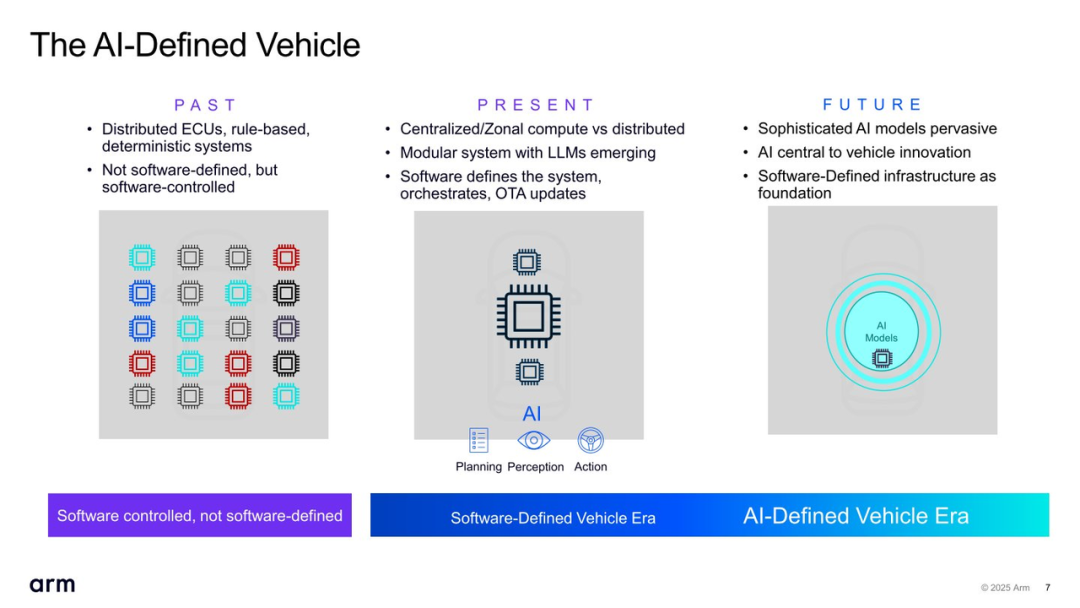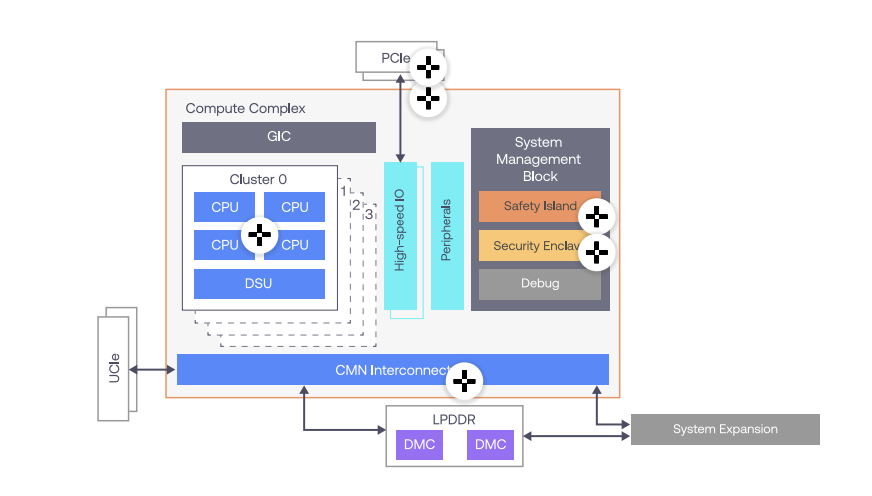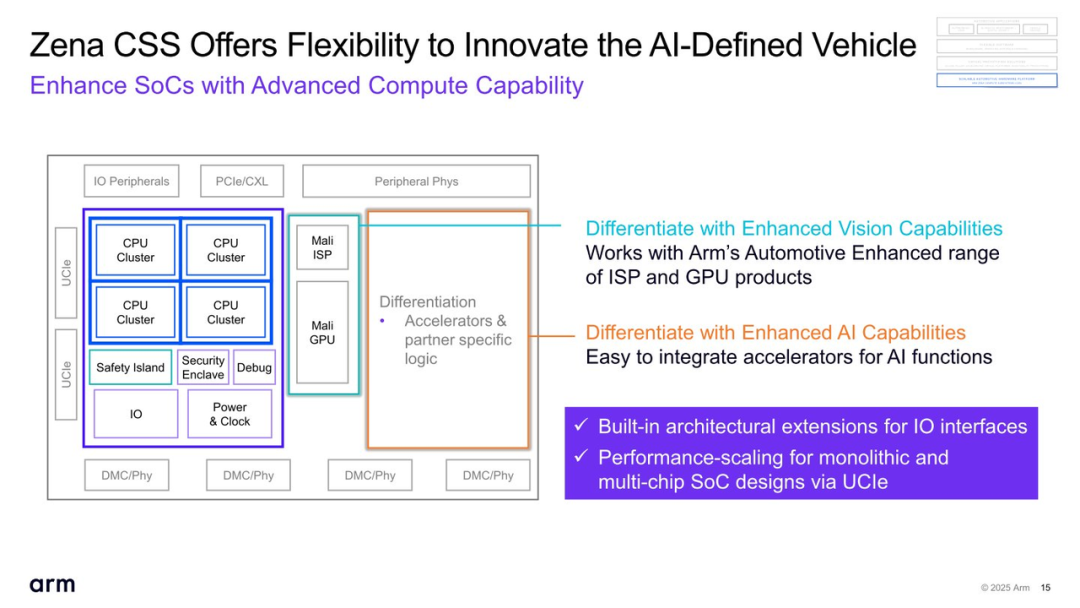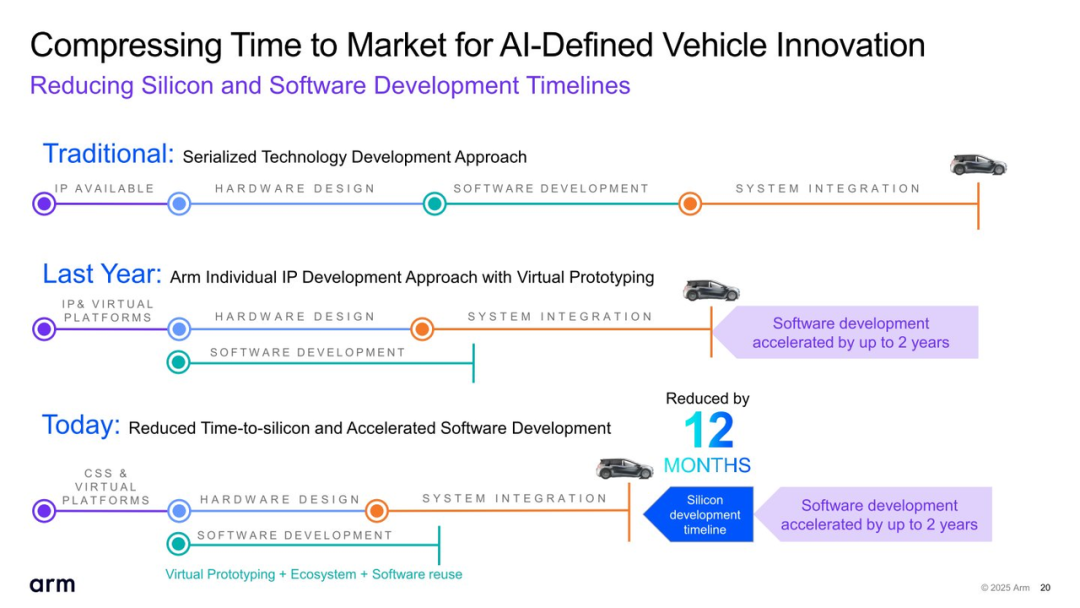 Produced by ZhiNeng ZhiXin
Produced by ZhiNeng ZhiXin
As the wave of automotive intelligence, software-defined vehicles, and AI accelerates, Arm’s introduction of the Zena Computing Subsystem (CSS) may bring significant changes, simplifying the development process of automotive chips and software, and providing a great path for Chinese automotive companies to customize and develop chips.
Through a standardized, pre-validated computing platform, Zena CSS enables the simultaneous initiation of software and hardware development, significantly shortening chip development cycles and vehicle time-to-market, laying a highly integrated, low-latency, and secure infrastructure for AI-defined vehicles.
We will delve into how Zena CSS brings disruptive efficiency leaps to the automotive industry from three dimensions: technical architecture, development pathways, and future trends, opening a new paradigm of seamless collaboration from “cloud to vehicle” for OEMs and Tier 1 suppliers.
 Part 1
Part 1
From Chip Definition to AI Definition:
Zena CSS Restructures the Automotive Electronics Development Paradigm

As AI penetrates the automotive sector, from voice assistants to autonomous driving, from personalized cockpits to edge perception reasoning, modern vehicles are shifting towards being intelligent entities centered around a “computing platform”.
Traditional development methods struggle to meet the complex system’s multiple demands for computing power, multi-task concurrency, safety, and flexibility, especially in the context of separated chip development, system validation, and software deployment cycles, leading to delays in the implementation of in-vehicle AI experiences. The emergence of Arm Zena CSS is a structural solution to this limitation.

Zena CSS is essentially a standardized in-vehicle computing subsystem based on the Armv9-AE architecture, characterized by its design philosophy of “pre-validated + pre-integrated”.
Its core consists of 16 Cortex-A720AE CPU cores optimized for ADAS and IVI workloads, supporting concurrent operation of multiple systems and possessing high-level virtualization capabilities.
Additionally, Zena CSS integrates a Cortex-R82AE-driven safety island, providing ASIL D level real-time fault tolerance capabilities, ensuring high reliability in fault detection, system control, and safety monitoring.

Zena CSS deeply embeds the root of trust (RoT) at the chip level, relying on the Arm TrustZone mechanism and runtime security engine to provide SoC-level hardware trust support throughout the entire process from boot loading, communication to OTA updates.
This software-hardware collaborative architecture is suitable for deep AI reasoning in advanced autonomous driving systems and can also handle strong real-time tasks in body control and basic functions, solving the long-standing problem of “functional domain silos” that are difficult to integrate.

The on-chip consistent interconnect architecture achieved through CMN S3AE significantly enhances data consistency, task scheduling, and resource sharing efficiency among multiple cores.
Moreover, the combination of Mali-C720AE ISP and Mali GPU provides image signal processing and graphics computing capabilities, adapting to typical AI use cases such as surround view, DMS, and AR-HUD, providing foundational support for integrated perception experiences in cockpits and assisted driving.
This computing platform not only possesses strong technical versatility but also boasts high “migration efficiency”.
Developers do not need to rebuild the underlying architecture and interface protocols for each vehicle model or chip but can reuse code and deploy applications across projects on a unified platform, greatly reducing the adaptation and validation costs brought about by software ecosystem fragmentation.
 Part 2
Part 2
Accelerating AI Adoption in Vehicles by One Year:
Standard Platform + Virtual Development as Dual Drivers
The key to Zena CSS truly disrupting the industry rhythm lies in its ability to enable a parallel development process where “software precedes chip availability”.
Traditional chip development cycles average 2-3 years, during which software teams often remain in a waiting state until the first batch of samples can initiate critical function debugging.
However, Zena CSS provides complete virtual platform support, allowing developers to build and test the entire software stack in advance on a cloud-based virtual hardware model through collaborations with ecosystem partners such as AWS, Cadence, Siemens, and Synopsys.
The effects of this capability extend beyond mere time compression—it essentially redefines the boundaries of vehicle architecture from design to delivery:
◎ Software teams can participate in hardware architecture optimization from the design phase, achieving collaborative design of software and hardware;
◎ System integrators can validate middleware adaptation, application compatibility, and AI model deployment strategies in advance, thereby enhancing platform robustness and deployment efficiency;
◎ OEMs can flexibly load functional modules based on different vehicle market positioning, achieving the collaborative goal of “platform unification + product differentiation”.

With Zena CSS, the average chip project can shorten the development cycle by 12 months, saving about 20% in engineering resources. More importantly, the software innovation cycle can be advanced by up to two years.
This means that while competing products are still waiting for sample validation, vehicle products based on Zena CSS are already capable of delivering a complete AI functional experience, opening a differentiated market window first.

The open standards behind the platform are also crucial.Zena CSS fully supports key protocols such as AUTOSAR, COVESA, eSync, and VirtIO, with the SOAFEE architecture serving as a unified framework for middleware, scheduling, virtualization, and service communication.
SOAFEE has integrated over 150 industry companies, including major global automakers and Tier 1 suppliers such as General Motors, CARIAD, Tata, and Continental, building an open, collaborative, and efficient smart automotive computing ecosystem.
Zena CSS also allows chip manufacturers and vehicle companies to flexibly add third-party AI accelerators or self-developed modules on its basis.
For example, integrating NPU, ISP, or VPU modules in Chiplet or logic block form into the standard interconnect architecture allows the SoC’s capabilities to be adjusted in real-time according to the scenario. This integrated “hybrid customizability” is a core feature pursued by automotive electronic systems in the AI era.

From architectural innovation to development leap, Zena CSS presses the fast-forward button for automotive intelligence
From a single chip product to a platform that defines vehicle capabilities, Zena CSS is no longer just a technical component but an important turning point in driving the automotive industry towards an AI-defined, software-driven, and real-time perception future.
By standardizing architecture, chip manufacturers no longer need to build platforms from scratch, and by providing a virtual development environment, software teams can break free from the constraints of hardware rhythms, while powerful heterogeneous processing and security mechanisms support edge intelligent reasoning and OTA management with hundreds of billions of parameters.
On the universal platform built by Zena CSS, vehicle companies no longer need to reinvent the wheel but can focus on creating differentiated experiences and ecological value.

Conclusion
With the full arrival of the AI automotive era, Zena CSS will become a key technological fulcrum driving “definition before implementation”, accelerating not just the emergence of a vehicle but the entire automotive industry towards a truly intelligent transformation. Smart vehicles are not only defined by chips but are AI entities driven by software and algorithms.